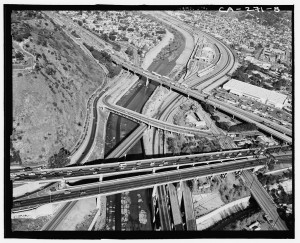South Glendale Freeway at right. Photograph by Brian Grogan/Historic American Engineering Record, Library of Congress
Can you imagine an Angelino saying, “I don’t have a car and don’t need one.” Yes, it can happen because the future is here and it offers many alternatives to individual car ownership.
As the city that became emblematic of car culture in the post World War II period, it is increasingly apparent that the infrastructure of freeways that wind throughout Los Angeles has become a paramount liability (social, financial and environmental) for all who live and work in the Greater Los Angeles area. Consequently, transportation reform has become a topic dominating the civic agenda.
The Los Angeles Live, Ride, Share conference on February 23, 2015 offered a stimulating agenda of transportation alternatives. For those who, in the visible age of global warming, consider that driving a fossil fuel powered vehicle to be a moral and social sin, this discussion was illuminating. It brought attention to viable alternative technologies, some already available, and others in development that offer the potential of a recognizable impact. Hopefully, they will contribute to an amelioration of the destructive practices that have become accepted globally.
No one in attendance thought that gasoline and diesel powered vehicles were going to disappear from the face of the earth in the near future; however, virtually all of the conference speakers proposed and described functioning examples of alternative methodologies utilizing apps and crowd sourcing – the technological modalities that are now reforming our daily lives.The conference agenda stressed replacing the single driver car with vehicles that maximize their passenger capacity and to develop better and more efficient use of the substantial automobile inventory populating the Los Angeles area.
Not to be overlooked is the reality that younger generations addicted to Facebook accept the “sharing economy” as an emerging reality in their lives. Today, only 67% of young people in California have drivers’ licenses. This indicates that an attitudinal change is already occurring. Although statistics were not offered, there is no question about an increase in bicycle ridership facilitated by the new bike lanes that are ubiquitous throughout LA City and LA County.
Where does the mobility hub fit into this equation?
Hillary Norton of FAST (Fixing Los Angeles Stuck inTraffic) describes mobility hubs as physical entities located near transit stops or railway stations that 24/7 could provide electronic access to transportation options (bus, subway. railway train and car share availability) in order to plan a journey whether it be short or long distance. They would be electronically hip convenience stores.
References were made to numerous success stories such as bike sharing in Paris, New York and Copenhagen, car sharing services like Car2Go, Zipcar, Lyft, Uber and the LA County Bicycle Coalition. They are pieces of the puzzle awaiting integration into a broader entity.
Have we seen the future anywhere? Yes. in London and Helsinki. Representatives from both cities spoke and described how they are planning and implementing strategies that will lead to a more efficient and economical use of physical and human resources. They see Los Angeles in a unique position to become a trail blazer in the development and implementation of these new urban strategies.
Footnote: There was little mention of Los Angeles County Sales Tax, Measure R, approved by voters in 2008. It provided for a half-cent sales taxes increase on each dollar of taxable sales (originating in or made from Los Angeles County) for thirty years in order to pay for transportation projects and improvements. The measure was approved by voters with 67.22% of the vote, just over the two-thirds majority required by the state of California to raise local taxes. The project was touted as a way to “improve the environment by getting more Angelenos out of their cars and into the region’s growing subway, light rail, and bus services.” It has already provided funding for some major mass transit projects. In addition, there has been effective lobbying in Washington to secure Federal funding.
Top image: A rendering of the NoHo Mobility Hub.

